Why do you need political campaign literature?
People are 70% more likely to remember things they see in print than online. However, digital advertising is ahead in consumption patterns, with 79% of people in the USA on social media consuming content for an average of six hours a day.
This is precisely why planning your political campaign literature is extremely important. When you begin your election campaigning journey, it is imperative to plan your messaging and how you will communicate it across mediums – print or digital.
This article explores types of print and digital campaign literature – and best practices to ensure your messages reach wider audiences.
Types of campaign literature (with examples)
Any print material that consists of election messaging can be considered part of political campaign literature. From brochures, pamphlets, to even recipe sheets – the examples of campaign literature can go as far as your imagination can take you.
Some popular and mainstream types of political campaign literature are:
- Posters
- Letters
- Brochures
- Websites
- Text messages
We explore each of these and browse through a few examples below. Read on.
Posters
The classic political advertisement tool, posters, have been used since the advent of printing. In fact, posters were the primary mode of political communication in the 19th century. Below is one such example, with Clarence McGregor from New York using a confident picture, bold typefaces, and simple content to advertise his election campaign.

Wondering why posters are still relevant? Well, this is why:
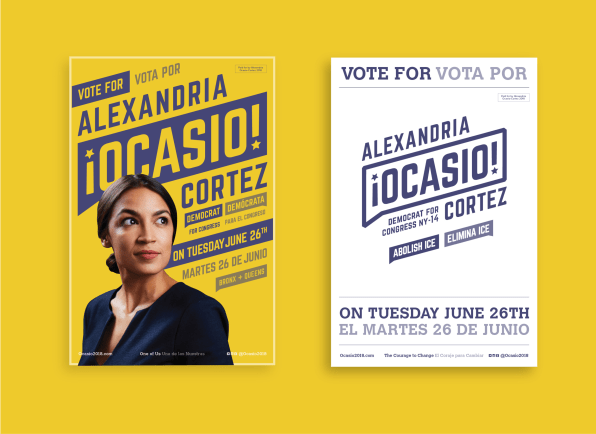
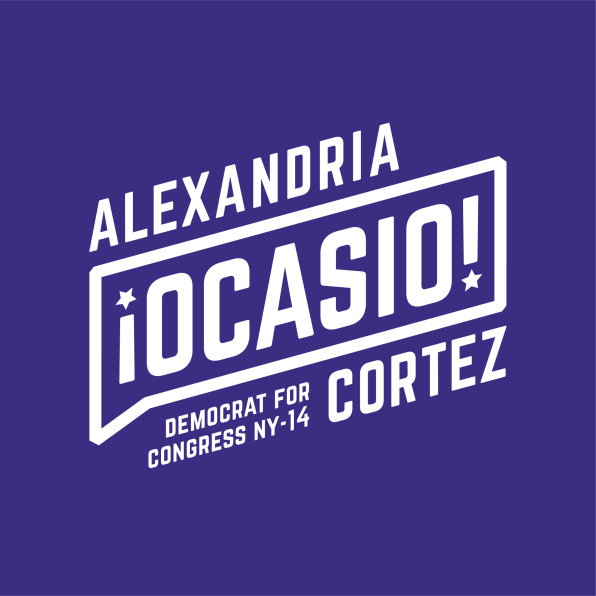
Alexandria Ocasio-Cortez’s election campaign in 2018 was widely popular, and her posters were vital in creating brand recall for her. Moving away from the traditional blue of the democratic party, Ocasio-Cortez instead opted for bold yellow and purple posters.
The result? Candidates everywhere are trying to replicate the success of this poster to stand out during their election campaign.
Key takeaways from AOC’s poster:
- Introduce yourself: AOC’s purple poster has only two bits of information – her name and the position she is contesting for – which are the two most important points your poster needs to cover. Even if you decide to add more text, ensure this information is highlighted.
- Focus on design: Your poster’s design communicates a lot of information to voters. Keep an eye out for the latest trends in design and adapt them to your poster design.
- Digital calls to action: Add digital calls to action to your poster, for example, by adding a website link on your poster that people can look up later or a QR code that leads to the campaign website.
Read Also: 5 Political Campaign Poster Ideas And Tips To Make An Impact
Letters
Letters form an integral part of political campaign literature. From appeals for support to fundraising, there are various ways in which letters are used in a political campaign.
A political campaign’s letter should always have the following elements:
- Personalized messaging while reaching out to the masses.
- A concise introduction of the candidate.
- A solid pitch for your campaign and its purpose.
- If it is an email newsletter, then links to donate, support, or sign up on their website.
- Links to social media so that people can continue to follow you and your messaging.
- A clear call to action or next steps – what is this letter trying to achieve?
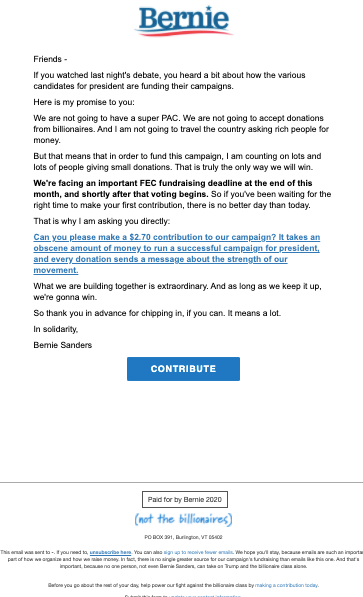
This piece of political campaign literature is Bernie Sanders’ donation appeal to his supporters. While donation appeals can be sent by both direct mail and email, emails help campaigns share links to encourage further action. Sanders’ email is the perfect example of what a political campaigning letter must consist of, which is:
- A personal introduction – The letter starts by addressing his supporters as ‘Friends,’ instantly building an emotional connection with the reader. Although he does not personalize the email by adding the reader’s first name, he still manages to strike a personal chord.
- Concise content – The letter does not spend too much time reaching the point it wants to convey, and it directly starts talking about the previous night’s debate.
- Call to action – The crux of the email, the ask for donations, is highlighted, drawing eyes to it immediately. You cannot miss what this letter is asking for.
- A personal connection – At the end of the letter, Bernie Sanders communicates empathy and gratitude by asking people to donate ‘if they can’ and ‘it would mean a lot’ – sealing the connection he fostered at the beginning with his greetings.
- An unmissable call to action button: Again, his call to action is reinforced by a simple but clearly visible ‘contribute’ button so that the readers can take that action immediately at the end of the letter.
Even though this is a visually basic letter with a simplistic design, it is highly effective due to how the power of words is harnessed.
Read Also: The Secret To Writing Political Donation Letters (With Samples)
Brochures
Brochures help win elections. The best kinds of political brochures are the ones that help you stand out from other candidates and also help spread your message to larger audiences. Brochures are fundamental parts of political campaign literature because they introduce the candidate and their policies to the masses online and offline.
A great example of a good political campaign brochure is Hillary Clinton’s from her 2016 Presidential campaign:
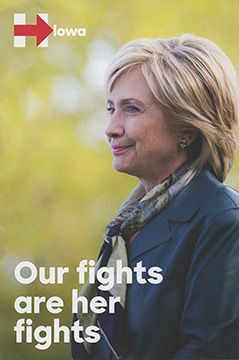
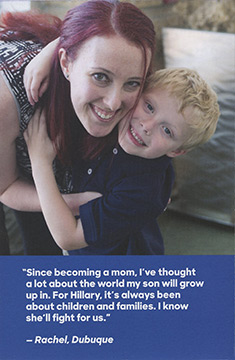

When designing your political campaign literature, using Hillary Clinton’s brochure as a guide might just be a good practice. It incorporates all the best practices of creating the perfect brochure, such as:
- A professional image of the candidate: Since a brochure is the voter’s introduction to a candidate, a professional image goes a long way in establishing a candidate’s potential. It helps people take the candidate seriously.
- Simple language: A great piece of political campaign literature is written simply but effectively. The language needs to be simple enough to be understood by everyone. Also, always proofread twice before you print something.
- Explain why voters should vote for a candidate: Clinton’s brochure above lists down policies she will support and her plans as the POTUS. Voters need to know why they should consider voting for a candidate and what the candidate can do for them.
- Creative: Hillary Clinton’s brochure stands out because she uses the image of a mother and child to evoke family feelings and incorporates a vote of confidence by including a quote from the mother.
- High-quality print: High-quality print shows how invested a candidate is in their election campaign. Focus on high-quality design and share your brochure through email. Avoid blurry images or illegible text.
Website
Being found online when people search for your campaign is essential when you are aiming to run successfully.
Your campaign website contains essential information, such as:
- Donation appeals and links.
- Introduction to the candidate and their policies.
- Social media links for continued engagement with the campaign.
- Call to action buttons that help support the campaign.
- Staff and volunteer recruitment.
- Updates from the campaign.
- Surveys and polls.
This is why you need to pay attention to how you design your website and its message. Take, for example, the website of the Mayor of Honolulu, Rick Blangiardi:
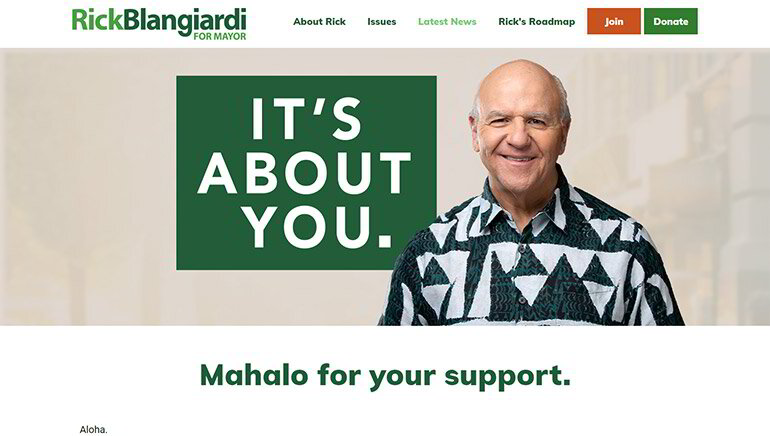
While this is a website with a simplistic design, it is apt for the Mayor of a Hawaiian city. Displaying a green and brown theme, with a t-shirt that evokes the feeling of being in Hawaii, this website is sure to appeal to his voter base.
While it is simplistic, the website uses a few things very well:
- Use of language: Using words such as ‘Aloha’ to instantly connect with the local audience and create a sense of belonging.
- Action buttons: This website uses two clear action buttons – Join and Donate. The readers know precisely what they need to do – either join or donate to help his cause.
- Pages: The ‘Meet Rick’ slide deck and ‘Women for Rick’ sections are important insights into him as a candidate and the policies that he supports – information that is vital as political campaign literature.
Overall, a simple but effective website is a great political campaign literature resource.
Text Messages
Yes, you read that right!
When the whole world is going digital, especially political campaigns, text messages also serve as crucial political campaign literature.
Political campaigns increasingly use text messages to reach out to voters because it guarantees a 98% open rate. Therefore, crafting a compelling text message to reach your target audience is extremely important in garnering support.
Here are some best practices to incorporate in your political texts:
- Determine which tools you want to use. You can select mass texting or peer-to-peer texting to drive one-way or two-way conversations, respectively. Once you determine that, you can craft your text message accordingly.
- Incorporate visual media. You can share posters and brochures via text messages using MMS features to make your text messages more engaging. This increases your conversion rates by up to 70% !!
- Make it actionable: Text messages are short pieces of campaign literature. However, you need to leverage it by adding a call to action, links for donation, links for support, or sharing on social media. The best part? You can even track these links and retarget your audience to increase support using the right text messaging tools.
We love Pete Buttigieg’s text message campaign that uses all of these best practices:

Here’s why Pete’s message works:
- Buddy and Truman: Yes, they get all the hearts! Including your pets in appeals is almost cheating – who will say no?
- It is short: The messaging is short, smart with using puns, and communicates exactly what it wants to achieve.
- Donation link: The call to action is clear and readers can immediately click on the link to donate. The donation link is also shortened to fit into one singular message, so the readers do not need to read two messages to receive the complete information.
Read Also: The A-Z of Political Text Messaging: Laws, Best Practices & Tools
Now that we’ve explored different types of political campaign literature, it is time to know some best practices while coming up with them for your campaign.
Best practices for crafting campaign literature
In addition to knowing the different types of political campaign literature, it is also essential to know some best practices while crafting them. We’ve listed a few that you would like to include:
- Be mindful of your audience: Know exactly who you are targeting and how your messaging will be perceived. While AOC’s yellow and purple posters were a great hit, they may not fit all candidates and their voter base.
- Create memorable messaging: Messaging that people can easily remember after coming across your political campaign literature is successful messaging. It could be Obama’s ‘Yes We Can’ slogan or Trump’s ‘Make America Great Again’ – both excellent, memorable messaging examples.
- Focus on design: As we learned earlier in the article, design is essential. While words will communicate what you want to, design signals your values to voters unconsciously. Focus on how you want to be seen through your political campaign literature.
- Know your intent: When creating content, always work backward. Know what you want as a result of your messaging and craft it accordingly. Is your campaign literature supposed to make people aware of your campaign, appeal for donations, or establish your credibility? Knowing your intent is imperative for clear messaging.
- Create different literature types for different audiences: Text messages work really well for younger audiences, while posters and brochures might appeal to slightly older audiences. High-value donors might prefer personalized letters. Knowing what type of political campaign literature works with which audience will lead to success.
- Design according to distribution: Knowing where your political campaign literature will be displayed goes a long way in determining design. Larger fonts for posters stuck higher up on walls, bright colors to draw attention to a busy junction, high-quality paper, and design for brochures available at the local community center – all these are points you must consider.
- Create content that can be repurposed: You may design posters to stick around essential places in the community, but you could also use their online drafts on your social media platforms, in your email campaigns, or share them via MMS messages. Creating repurposable content saves time, effort, and valuable campaign funds.
- Use technology: Political campaign literature has been traditionally understood as print material. But with the introduction of texting, newsletters, social media, etc., into the campaign process, you must plan for messaging that appeals across platforms.
Conclusion
Designing your political campaign literature is one part of running a successful campaign. However, it still requires a lot of consideration and careful planning.
Want to know more about how to run successful election campaigns? Read Your 8 Step Guide On Planning Local Political Campaigns That Win! to learn more and follow our blog.
Feature Image Credit: Mikhail Nilov


